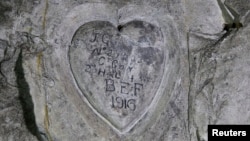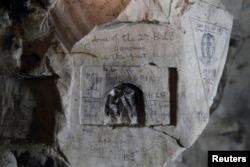Neglected for decades, underground caves in a small village in France's Somme valley contain a treasure trove of hundreds of engravings by
World War I Canadian and British soldiers as they sought refuge from German assaults.
War researchers say the engravings in the chalky rocks of Bouzincourt, which range from inscriptions of a soldier's name to crudely carved flags and hearts, offer a powerful insight into the thoughts of those caught up in the Somme Offensive, one of the bloodiest battles of the 20th century.
"They knew that they may be about to die. We all want to be known, we all want to feel like our lives matter. And so here on these walls we see them writing their last message to all of us, not knowing if anyone would ever see it," Jeffrey Gusky, a U.S. medic who for the past 20 years has gathered images for a photo project called "The Hidden World of WWI", told Reuters TV.
Accessible by small spiral stairs in the village church, the caves, some 12 meters (yards) under the surface, were used by locals to store food and shelter their families and livestock as early as the 17th century.
Their significance in war history has only just started to emerge thanks to the work of researchers like Gusky and local volunteers who, encouraged by the upswell of interest in the war during last year's centenary of its start, have started offering more regular tours on a request basis.
Most of the inscriptions date back to 1916, many from July of that year when the Battle of the Somme started. Some 20,000 British soldiers were killed on the first day; by the battle's end in mid-November, the two sides had together suffered over a million casualties.
Many of the shapes carved out of the cave walls are designed specifically to allow a postcard to be inserted there; others are inscriptions of the name of a soldier, often followed by details of his injuries. Of the 829 names recorded in the caves, around 500 are of Canadian soldiers, Gusky said.
Above ground is a small cemetery for war dead with special relevance to British visitors — it holds the grave of Lieutenant Lionel Lupton, an ancestor of Catherine, Duchess of Cambridge.







